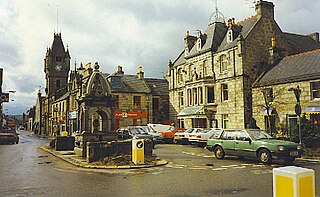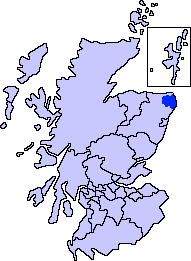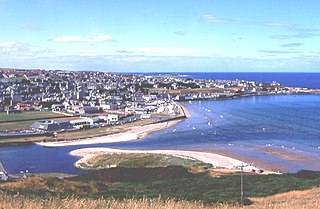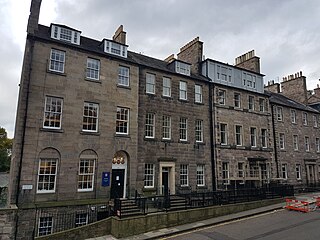
Huntly is a town in Aberdeenshire, Scotland, formerly known as Milton of Strathbogie or simply Strathbogie. It had a population of 4,460 in 2004 and is the site of Huntly Castle. Its neighbouring settlements include Keith and Rothiemay. Both Huntly and the surrounding district of Gordon are named for a town and family that originated in the Border country.

Buchan is an area of north-east Scotland, historically one of the original provinces of the Kingdom of Alba. It is now one of the six committee areas and administrative areas of Aberdeenshire Council, Scotland. These areas were created by the council in 1996, when the Aberdeenshire council area was created under the Local Government etc (Scotland) Act 1994. The council area was formed by merging three districts of the Grampian Region: Banff and Buchan, Gordon and Kincardine and Deeside. The committee area of Buchan was formed from part of the former district of Banff and Buchan.
The Belle River is a 73.5-mile-long (118.3 km) river in the U.S. state of Michigan, flowing into the St. Clair River in Marine City at 42°42′25″N82°29′50″W.

Diocese of Aberdeen was one of the 13 dioceses of the Scottish church, before the abolition of the episcopacy in 1689.
Ronald Center was a Scottish composer.

The River Deveron, known anciently as the Dovern, is a river in the north east of Scotland. The river has a length of 60 miles (97 km), and has a reputation for its Atlantic salmon, sea trout and brown trout fishing. In its upper reaches peaty water flows over a bottom of shingle and rock and is fast flowing.
Strathbogie is a district and river valley of northwest Aberdeenshire in Scotland, formerly one of the great divisions of that shire, called lordships or thanages, comprehending the whole original estate that King Robert the Bruce gave to the noble family of Gordon, the ancestors of the Duke of Gordon. By 1836, the lordship had become extinct.

Banff is a town in the Banff and Buchan area of Aberdeenshire, Scotland. It is situated on Banff Bay and faces the town of Macduff across the estuary of the River Deveron. It is a former royal burgh, and is the county town of the historic county of Banffshire.

Texa is a small island 700 metres directly south of Islay, in the Inner Hebrides, Scotland. It reaches a height of 48 metres at its highest point, Ceann Garbh. It is part of the parish of Kildalton on Islay. The distilleries of Laphroaig and Lagavulin are nearby on the Islay coast, as well as Port Ellen. It is currently uninhabited, but is home to wild goats, as well as otters.

Inverkeithny is a village in the Formartine area of Aberdeenshire, Scotland. The village lies near where the Burn of Forgue flows into the River Deveron, 7 miles (11 km) west of Turriff and 3 miles (5 km) south-east of Aberchirder. In 1990, it was described by Charles McKean as "near-deserted".
Blairmore School was an independent boarding preparatory school in Glass near Huntly, Aberdeenshire until its closure in 1993. The site is now owned and used by a Christian organisation called Ellel Ministries International as a prayer, training and healing retreat centre.

Lumsden is an inland village in Aberdeenshire, Scotland on the A97 road.

Turriff United Football Club are a senior football club currently playing in the Highland Football League in Scotland. They play their matches at The Haughs, beside the River Deveron in Turriff, Aberdeenshire. They joined the Highland League for the 2009–10 season, having been accepted into the league on 25 February 2009. Prior to joining the Highland League, they were a Scottish Junior Football Association club, playing in the Scottish Junior Football North Premier League.

The School of Scottish Studies was founded in 1951 at the University of Edinburgh. It holds an archive of approximately 33,000 field recordings of traditional music, song and other lore, housed in George Square, Edinburgh. The collection was begun by Calum Maclean - brother of the poet, Sorley MacLean - and the poet, writer and folklorist, Hamish Henderson, both of whom collaborated with American folklorist Alan Lomax, who is credited as being a catalyst and inspiration for the work of the school.

Avochie Castle is a ruined tower house, dating from the 16th century, or early 17th century, around 4.5 miles (7.2 km) north of Huntly, east of the river Deveron, in Aberdeenshire, Scotland.

Sheila Stewart was a Scottish traditional singer, storyteller, and author. She inherited a large number of traditional songs from older family members, including her mother Belle Stewart.
Deveron Projects, formerly Deveron Arts, is a United Kingdom arts organisation based in Huntly, Aberdeenshire, Scotland that hosts international artists from a variety of disciplines to collaborate with the town community. Deveron Projects follows a '50/50' approach, which gives equal attention to impact on the local community and impact on the international art scene. Residencies have been provided to artists from China, the Americas, India, Africa and mainland Europe as well as North East Scotland.
Idoch Castle was a 14th-century castle about 3 miles (4.8 km) east of Turriff, Aberdeenshire Scotland, near Idoch Water, a tributary of the River Deveron.
The Castle of King Edward is a 13th-century ruined castle near King Edward, Aberdeenshire, Scotland, located 6 kilometres (3.7 mi) north of Turriff, where the A947 crosses the Burn of King Edward, and 2 miles (3.2 km) east of the River Deveron. The castle was the caput of the feudal barony of King Edward.
Gartly Castle was a 15th-century castle, about 1 mile (1.6 km) north-east of Gartly, Aberdeenshire, Scotland, and 4 miles (6.4 km) south of Huntly, east of the River Bogie.












